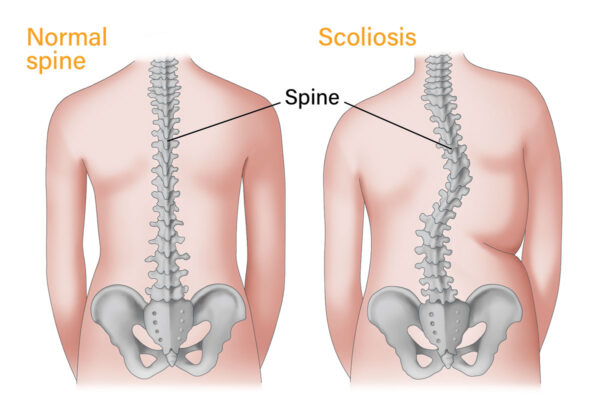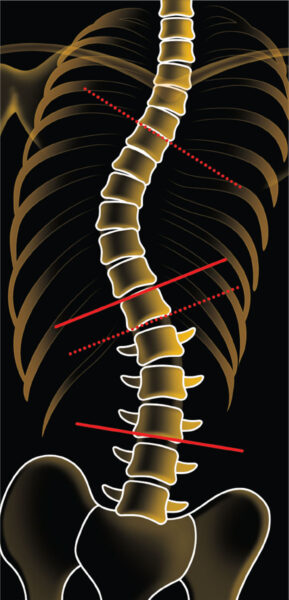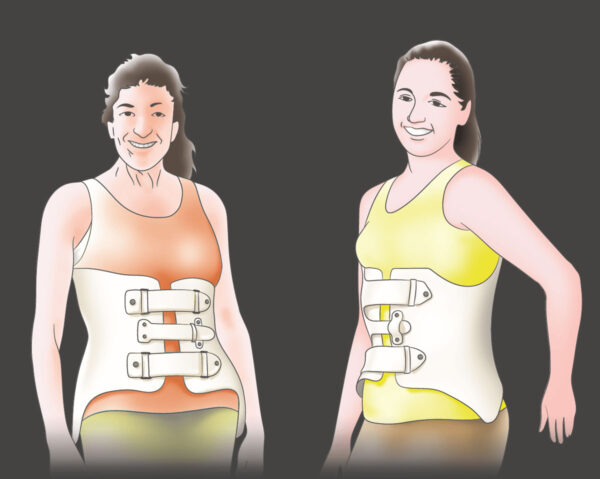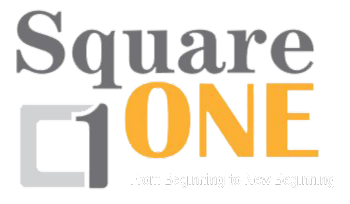Adult Scoliosis Treatment – Find Your Best Option
Adult scoliosis is a condition in adults that causes the spine to curve to one side. Depending on the severity of the curvature, it can be both painful and debilitating. Common signs and symptoms include back pain, pain going down the leg (sciatica), increased pain in the legs with walking or exercise, uneven shoulder height, unlevel hips, reduced flexibility, difficulty breathing, and fatigue.
Although adult scoliosis can never be fully corrected (meaning completely “fixed”), the proper treatment can help manage symptoms, prevent progression, and improve quality of life.

how scoliosis looks compared to a normal spine
Understanding Adult Scoliosis
Adult scoliosis is more common than you might realize. It’s estimated that as many as 38% of adults between the ages of 40-90 have scoliosis. Although scoliosis is defined by spinal curvatures greater than 10 degrees with rotation, most adults diagnosed with scoliosis tend to have curvatures that have already progressed past 30 degrees.
There are two primary types of scoliosis in adults. First, there is adult idiopathic scoliosis, which refers to adults who have had scoliosis since childhood. Then there is adult de novo scoliosis, a condition that develops with age. Degenerative scoliosis typically occurs in adults over 40 years old due to the natural degeneration of the discs, facet joints, and ligaments. Adult degenerative scoliosis can be idiopathic scoliosis that was present as an adolescent that degenerates and progresses in adulthood or a new (de novo) degenerative scoliosis that develops in adulthood.
When Should Adults Screen For Scoliosis?
Certain physical signs can indicate you might have scoliosis. For example, if you have an unnatural posture that forces you to lean forward due to stiffness and lower back pain. Another common sign of scoliosis is a lateral shift of the body when viewed from the front or back. Adults with scoliosis are much more likely to experience pain than adolescents with the condition as well.
In addition, if you experience cramping, numbness, or shooting pains in your legs, it could result from pinched nerves caused by scoliosis. Many adults with scoliosis will experience increased pain in the legs with walking or exercise, this is called intermittent claudication. If you have any of these physical signs or symptoms, you should be screened for scoliosis as soon as possible.

Early diagnosis is essential because scoliosis can cause many complications, including chronic pain and reduced flexibility, that can worsen over time. It’s also crucial for adults to get screened because treatment options are more effective when scoliosis is diagnosed early.
How We Help Our Patients Through Scoliosis Screening
At Square ONE Health, we offer comprehensive scoliosis screening for adults. We know exactly what to look for when evaluating a patient for scoliosis. We perform specific tests, such as the Adam’s Forward Bend test, performed with a scolimeter, which can detect rotation in the spine.
A detailed posture analysis can help us identify any changes in the shape of your spine and any waistline asymmetry, shoulder blade asymmetry, and trunk shift. If we suspect scoliosis, we will perform x-rays to confirm the diagnosis and evaluate for severity and treatment options. An MRI may be recommended if neurological symptoms are present.
Diagnosing Adult Scoliosis
If a physical exam reveals a curvature in the spine, we will order X-rays or MRI scans to get a clearer picture of the condition and to properly diagnose adult scoliosis. X-rays allow us to see the structure of the vertebrae, which can help us identify abnormal spinal curvatures and determine the extent of the curvature.
X-rays will also help us identify other potential issues, such as bony deformities, unequal leg length, lateral shifts in the vertebrae called olithesis that could be causing the spine to curve abnormally.
We may also perform a magnetic resonance imaging (MRI) scan, which allows us to evaluate soft tissue and can be used to evaluate potential spinal cord or nerve root compression.

drawing of spinal scan
Non-Surgical Treatment For Adult Scoliosis
Unless the spinal curvature is severe (over 60 degrees), adult scoliosis can be successfully managed and treated without surgery in most cases. Treatment options will depend on the underlying cause of the condition, the severity of the curvature, and how much pain you are in.
At Square ONE, we will always recommend non-surgical treatment options first, as they have fewer risks and side effects. Even if the curvature is severe, we will attempt to stop progression and correct the curvature conservatively so that it doesn’t exceed the threshold for surgery, which is typically around 60 degrees.
With that in mind, the following are some of the non-surgical treatment solutions that we offer for adult scoliosis:
Monitoring
In cases where the spinal curvature is mild (meaning less than 20 degrees), we will monitor it to ensure that it doesn’t get worse. In addition, we will take regular X-rays to track the curvature progression over time.
You may not require further treatment if the curvature is mild and remains mild with little to no progression. However, we will recommend further treatment if we observe that the curvature is progressing. Treatments may be prescribed to reduce symptoms if back pain is present.
Rehabilitation And Exercise
Rehabilitation and exercise are essential components of scoliosis treatment. Because scoliosis can limit flexibility, specific scoliosis-based exercises and chiropractic biophysics (CBP) therapy can help improve the spinal alignment, increase the range of motion, and help reduce pain.
We also prescribe core strengthening exercises to help build the muscles around the spine. Doing so can help prevent progression and provide stability, which can also help with pain relief. Rehab and exercise can be effective at any stage of scoliosis, whether you have a mild or severe curvature.
Custom Scoliosis Brace
If you have a moderate curvature and regular rehabilitation and exercise haven’t stopped the curvature from progressing, we may recommend wearing a brace. Custom scoliosis braces have been shown effective to slow or stop progression and in some cases correct the spine.
However, at Square ONE, we use the ScoliBrace. Off the shelf bracing may provide some temporary pain relief but they have not been shown effective in slowing scoliosis progression in adults.
The ScoliBrace is a custom brace tailored to your body type using 3D scanning technology. It is designed to stop the progression of scoliosis and correct existing curvatures by overcorrecting them. The ScoliBrace is comfortable, lightweight, and easy to take on and off (unlike most other types of braces).
Scoliosis in adults can be complicated and each brace has to be custom-made for each individual patient to address their unique spinal issue.

example of scoliobraces
Surgical Options For Scoliosis In Adults
In rare cases, non-surgical treatments may not be effective. If your spinal curvature has exceeded 60 degrees and shows no signs of slowing down despite our best efforts, we may recommend surgery as a last resort. It’s important to note that we rarely recommend invasive procedures because of the risk of potential complications especially in older adults..
With that in mind, the following are a few of the situations in which surgery may be the best option for treating adult scoliosis:
Severe Curvatures In The Spine
If the spinal curvature is severe (over 50 degrees), it can severely limit a person’s range of motion and flexibility, not to mention their ability to perform day-to-day tasks. Therefore, surgery may be the only option if the curvature is severe and continues to progress despite non-surgical treatment.
Severe Back Pain
Severe back pain can be challenging to live with. Surgery may be recommended if the scoliosis is causing severe back pain and no other treatment is helping to alleviate that pain. At Square ONE Health, we want to avoid prescribing painkillers to our patients as these do not address the root cause of the problem and can cause serious side effects (as well as be addictive).
Squashed Or Irritated Nerves In The Spine
In some cases, spinal degeneration, arthritis and disc bulges or herniations can lead to radiculopathy, which is when the spinal nerves become compressed or irritated. Nerve compression can cause pain, weakness, numbness, and tingling in the arms and legs. Surgery may be recommended if the nerve compression is severe and doesn’t respond to other treatments.
The Risks And Consequences Of Surgery
At Square ONE, we only recommend surgery if there is truly no other option. Surgery has too many risks to be recommended over non-invasive treatments, such as scoliosis-based exercises, CBP therapy, or bracing. The following are a few of the reasons why we recommend against surgery whenever possible:
Pain Is Not Eliminated Completely
Unfortunately, surgery may not completely alleviate the pain caused by adult scoliosis. In fact, many people continue to experience pain or stiffness after surgery. In some cases, patients may even experience more pain or a different type of pain following surgery. This can happen if the surgery is unsuccessful or if it affects the muscles and joints surrounding the spine.
Lung Function Is Affected
Scoliosis surgery can also affect the pulmonary function of the patient – meaning, their lung function. The incision made during the operation can cause the lungs to not function as effectively because the chest wall becomes more rigid. In extreme cases, the lungs may not be able to expand and contract enough to take in oxygen properly.
Damage To Psychological Health
Scoliosis surgery can also affect psychological health. The operation is major and invasive, which can be emotionally and psychologically taxing for the patient. The lead up to the surgery can also be particularly stressful, causing anxiety, depression, or other mental health issues that may linger even after the procedure has been completed.
No Improvement In Quality Of Life
There is no guarantee of success when it comes to surgery to correct scoliosis. Even if the scoliosis is successfully corrected, there is no guarantee that it will improve the patient’s quality of life. In some cases, they may still experience pain and discomfort due to the residual effects of their condition.
Put Yourself First With Square ONE Health
It’s important to understand that most general practitioners don’t fully grasp the complexities of scoliosis and its treatment. More often than not, they’ll recommend pain medications and steroid injections, which may address the symptoms of scoliosis, but won’t address the underlying cause.
Not to mention, these solutions can potentially lead to negative health consequences as well.
At Square ONE Health, we specialize in treating scoliosis. As a result, we can properly diagnose your condition and create a personalized, non-invasive treatment plan that will not only help manage your symptoms, but also prevent progression and improve your overall quality of life.
We offer a range of treatments, such as scoliosis-based exercises, CBP therapy, and bracing, to help reduce pain and improve posture without the risks associated with surgery.
Square ONE offers the most modern intensive scoliosis treatment in Fort Collins. Contact us today!
